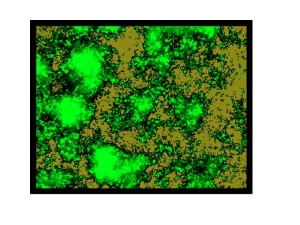
Through genetic engineering, this Vibrio cholerae biofilm can be loaded with extra antigens, creating a super-charged but inexpensive vaccine.
Paula Watnick, MD, PhD, an infectious disease specialist at Boston Children’s Hospital, has a plan that stems from her work on cholera: using a substance produced by the bacteria themselves to make inexpensive and better vaccines against them.
Cells do all the work
Bacteria produce biofilms—a sticky, tough material composed of proteins, DNA and sugars—to help them attach to surfaces and survive. In working on a cholera vaccine, Watnick’s group learned that the Vibrio cholerae cell makes large amounts of a key protein, RbmA, that congregates outside of the bacterial cell in its biofilm matrix.
The biofilm is a huge sink for the RbmA protein, and that led to Watnick’s idea: to use this observation to create a super-charged cholera vaccine—and have the bacteria do all the work. She and her colleagues genetically engineered the cholera cell to over-produce a so-called fusion protein—a combination of the RbmA protein and the cholera toxin B subunit antigen, the main cholera antigen recognized by the immune system.
“By genetically manipulating the cell to mass-produce the fusion protein, you can get tons of it into the matrix,” says Watnick. In a recent paper, she proved that the manufacturing concept works.The vaccine, then, is the engineered V. cholerae bacterium itself. Keeping to the current killed, whole-cell oral vaccine approach, it would cost no more than today’s cholera vaccine (about $1/dose) and hopefully exceed the current 60 to 70 percent protection rates.
“Our vaccine would be stored and administered exactly like the killed whole-cell vaccine that has been adopted by all resource-stressed countries,” says Watnick. “It is just using genetically engineered bacteria instead of wild-type Vibrio cholerae.”
Supported by Boston Children’s Hospital’s Technology Development Fund, Watnick and postdoctoral fellow Daniel Smith are soon beginning the first vaccine trial in mice, looking at how the immune system responds to the antigens attached to the over-produced RbmA protein.
A multi-antigen vaccine platform
Watnick’s vision isn’t limited to cholera. Her great hope is to develop a new, inexpensive vaccine platform that is more effective than what is available and could cover more than one disease.
“The biofilm matrix is a huge reservoir that can contain tons of proteins, fused to any sort of antigen you are interested in,” she says. “We think perhaps we can attach antigens against many diarrheal pathogens to the RbmA protein and then get Vibrio cholerae to make the whole thing.” Potential targets may include enterotoxigenic Escherichia coli, shigella and non-typhoid salmonella.
Imagine a simple killed, whole-cell vaccine decorated with many types of antigens instead of just one. The result would be a more general vaccine that protects against many diarrheal diseases at once. Going further, Watnick hopes to bring this new vaccine platform to other disease categories.
Watnick’s technology, available for licensing, is further described here.
Alice McCarthy is a science writer covering biomedical research and the latest in new medical treatments.
Join us at the Global Pediatric Innovation Summit + Awards 2014 on October 30-31 at Boston’s Seaport World Trade Center. Seats are limited, so register today at www.takingontomorrow.org. Please use the code VECTOR at check-out for a 10% discount.








